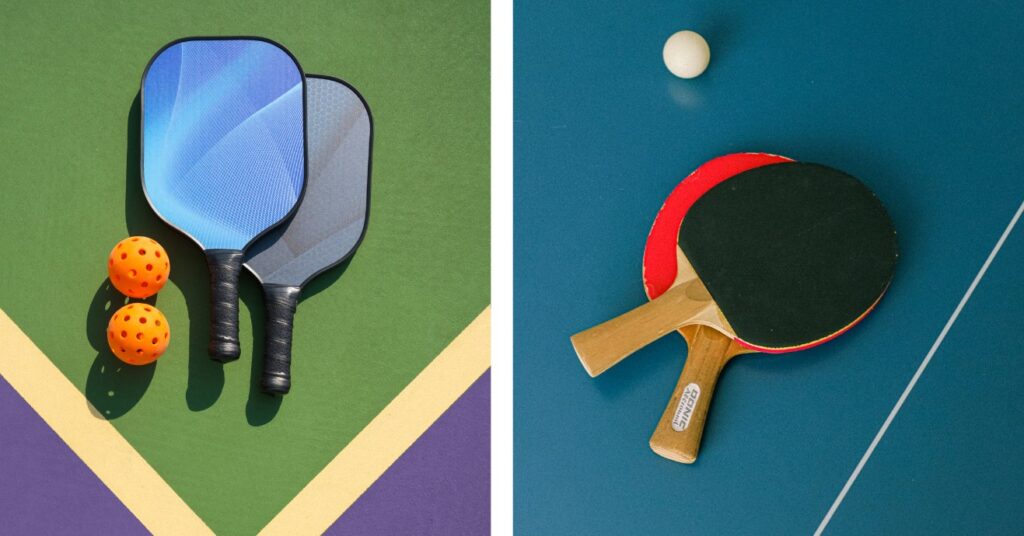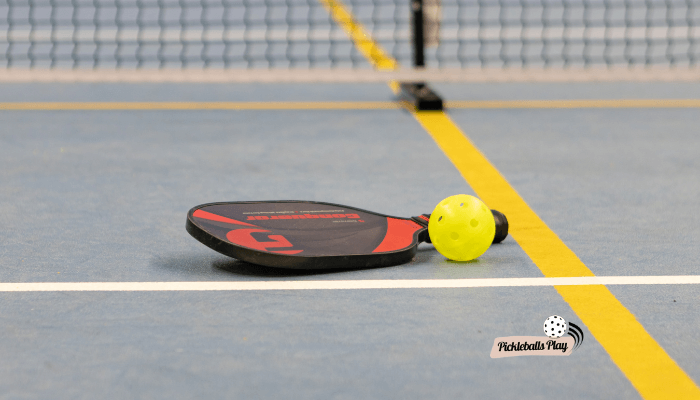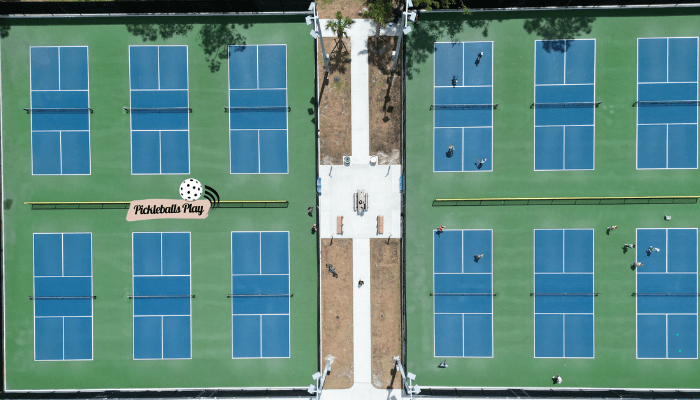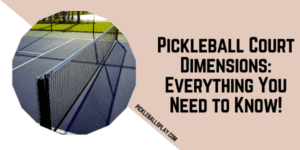Are you searching for a thrilling and enticing way to keep fit while improving your hand-eye coordination? Look no further than the exhilarating world of racquet sports! Ping-pong (table tennis) and pickleball are two popular options that offer unique benefits. But what sets these two games apart (Pickleball vs. Ping Pong), and which one should you give a try?
In this engaging blog post, we’ll delve into the wonderful world of ping pong vs. pickleball, breaking down everything you need to know. By the end, you’ll be equipped with the knowledge to make an informed decision and prepare yourself for a serve of phenomenal fun!

What Is the Difference Between Pickleball vs. Ping Pong?
In terms of racquet sports, both ping pong and pickleball demand quick reflexes, sharp hand-eye coordination, and a competitive spirit. However, there are key distinctions between these two games. So, let’s dive into the realm of Pickleball vs. Ping Pong:
Table
Ping Pong is played on a smaller, rectangular table measuring 9 feet long and 5 feet wide.
On the other hand, pickleball is played on a larger court, with the net standing tall at 36 inches high. A pickleball court is 20 feet wide and 44 feet long for doubles, and 20 feet wide and 22 feet long for singles. The larger size of the pickleball court allows for extended rallies and increased movement on the court.
Net
The height difference between the nets used in Ping Pong and Pickleball is significant. Ping Pong’s net is a mere 6 inches high, which facilitates faster gameplay and requires players to send the ball low over the net.
In contrast, Pickleball’s net is at a lofty 36 inches, making it easier to clear but also resulting in a slower-paced game that affords players more time to react to shots.
Ball
The Ping Pong ball measures approximately 40mm in diameter, made of celluloid material, and weighs a mere 2.7 grams.
On the other hand, a pickleball ball boasts a diameter of about 74mm, weighs approximately 26 grams, and features holes throughout its surface, creating wind resistance and reducing the ball’s speed. The slower pace and controlled flight path of a pickleball make it more beginner-friendly and appealing to older adults. The larger size of the ball also makes it easier to hit and control with the paddle.
Paddle
The discrepancy in paddle size and weight is due to the differing gameplay styles of Ping Pong and Pickleball. Ping Pong is a fast-paced game that necessitates quick reflexes, so the paddle is lightweight and easy to handle.
Conversely, Pickleball is played at a slower pace, so the paddle is larger, heavier, and equipped with a thicker grip to provide more control and power when striking the ball.

Court
Pickleball is played on a court that is 20 feet wide and 44 feet long for doubles, and 20 feet wide and 22 feet long for singles.
In contrast, Ping Pong is played on a much smaller rectangular table measuring 9 feet long and 5 feet wide. The larger court size appeals to the physically demanding nature of pickleball, allowing for longer rallies and increased movement.
Scoring
In Ping Pong, each game is played up to 11 points, with the winner needing to hold a lead of at least two points.
In Pickleball, the game is played up to 21 points, and the winner must maintain a lead of at least two points. The difference in the scoring system affects the pace of the game, with Pickleball generally taking longer than Ping Pong.
Serving
In Ping Pong, underhand serving is a strict rule. The server must toss the ball up at least 6 inches and strike it with the paddle from behind the end line.
In Pickleball, players have the freedom to serve both underhand and overhand, providing more flexibility and variety in the game. The serve must be below the waist and executed underhand, with the paddle positioned below the wrist.
The Cost
The cost of playing Ping Pong and Pickleball primarily depends on the quality of equipment you choose. Ping Pong requires a table, net, paddles, and balls, while Pickleball necessitates a court, net, and balls.
Pickleball equipment tends to be pricier due to the larger court size and the requirement for outdoor play. On the other hand, Ping Pong can be played indoors or outdoors with less expensive equipment.
Benefits of Playing Each Sport
Both Ping Pong and Pickleball offer fantastic exercise opportunities and can be immensely enjoyable. They are simple to pick up, requiring only a few pieces of equipment to begin playing. Let’s take a look at some of the advantages of each sport:
Ping Pong
Ping Pong, also known as table tennis, has been a beloved game for centuries and can be played regardless of age or skill level. It serves as a fantastic way to remain active, have fun, and enhance mental well-being. Here are some of the benefits of playing Ping Pong:
- Improved Hand-Eye Coordination: Ping Pong demands quick reactions and excellent hand-eye coordination to accurately return the ball over the net. Practicing this sport will enhance your ability to move swiftly while keeping track of the ball’s trajectory.
- Improved Physical Fitness: Engaging in Ping Pong involves plenty of running around and quick bursts of energy, aiding in maintaining bodily fitness and overall health.
- Stress Relief: Once immersed in a game of Ping Pong, it’s easy to forget any external worries or stress. The excitement of the sport allows you to focus on the fun of competing against opponents or friends, with the outcome mattering less than the enjoyment derived from the experience itself!
- Brain Stimulation: Ping Pong requires fast reflexes alongside strategic planning for future shots. Consequently, it helps stimulate various areas of your brain, resulting in improved cognitive function over time.
All in all, Ping Pong presents numerous physical fitness benefits and enhances cognitive functioning, making it an ideal activity for individuals of all ages, from children to adults!

Pickleball
The sport of pickleball skillfully blends elements from tennis, badminton, and ping pong. It can be played indoors or outdoors, making it suitable for individuals or teams of all ages. Besides being easy to learn, the game offers a variety of benefits for players of all skill levels.
- Excellent Cardiovascular Workout: Pickleball provides a superb cardiovascular exercise. Players must navigate the court, chasing balls, and performing quick sprints to reach their opponent’s shots. In essence, it improves endurance, leg strength, and burns calories!
- Enhanced Hand-Eye Coordination: With its fast-paced nature, pickleball sharpens hand-eye coordination, as players must react swiftly when striking shots over the net.
- Strategic Thinking: Pickleball hones strategic thinking skills as players must anticipate the direction of their opponents’ shots and position themselves accordingly on the court. This mental aspect adds an extra layer of challenge and excitement!
- Social Interaction: Playing pickleball is a fantastic way to bond with like-minded individuals. Whether engaging in singles or doubles games with family and friends at home or participating in organized competitions at local clubs, this sport fosters connections and an enjoyable competitive environment!
All in all, pickleball is a thrilling and safe sport that offers a wide range of physical, mental, and social benefits. With its simple rules and immersive gameplay, it’s no wonder this increasingly popular game has captured the hearts of so many!
Frequently Asked Questions
What are the similarities between pickleball and ping pong?
The two games share several similarities. Pickleball and ping pong both involve hitting a small ball over a net using paddles. They can be played indoors or outdoors and require quick reflexes and hand-eye coordination to score points. However, each game has its own distinct set of rules.
Is pickleball harder than table tennis?
While there is no definitive answer as to which game is harder, many believe that pickleball is more complex than table tennis. This is due to the larger court size and different playing rules. Additionally, pickleball players must adapt their strategy based on the serves they receive, whereas table tennis players typically rely on a consistent stroke.
Are table tennis players good at pickleball?
Table tennis players may have certain advantages when playing pickleball, such as enhanced eye-hand coordination and experience hitting spin shots. However, the two sports are different enough that a table tennis player would need to practice extensively to become proficient at pickleball.
Conclusion
In conclusion, we have explored the differences between pickleball and ping pong (Pickleball vs. Ping Pong).
Both pickleball and ping pong are incredible sports that offer exceptional benefits. Ping pong is ideal for those looking to refine hand-eye coordination and reflexes, while pickleball presents a full-body workout that improves cardiovascular health.
If you haven’t yet given these sports a shot, grab a paddle and ball! You may discover a newfound passion along with surprising physical and mental advantages.


